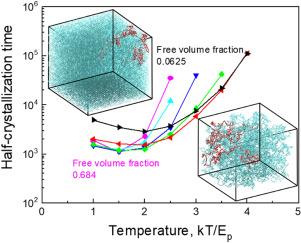NH2-MIL-88中PLA立体络合加速的研究:自由体积的影响
IF 4.5
2区 化学
Q2 POLYMER SCIENCE
引用次数: 0
摘要
本研究将可生物降解的聚乳酸外消旋共混物(PRB)史无前例地渗透到铁基MOF-NH2-MIL-88 (NM88)中,并对其立体配位进行了详细的探讨。在NM88中,PRB在冷却时表现出较低的结晶温度和加热时较低的熔化温度。等温结晶动力学表现出明显的加速,特别是在较低温度下。此外,介电特性表明MN88中PRB的玻璃化转变温度较低。我们认为自由体积分数的增加可能是上述观察结果的原因。通过调整自由体积分数,我们进一步进行了一系列的分子模拟,结果与实验数据一致。研究表明约束内链的行为不仅受界面约束和几何约束的影响,还受环段环境的影响。它还揭示了由金属有机框架(MOFs)和聚合物材料组成的杂化材料。本文章由计算机程序翻译,如有差异,请以英文原文为准。


Insight into the acceleration of PLA stereocomplexation within NH2-MIL-88: Influences of free volume
In this study, biodegradable PLA racemic blends (PRB) were infiltrated into an iron-based MOF–NH2–MIL-88 (NM88) unprecedentedly, and their stereocomplexation was explored in detail. Within NM88, PRB demonstrated a reduced crystallization temperature during cooling and a lower melting temperature upon heating. Isothermal crystallization kinetics showed a significant acceleration, particularly at lower temperatures. Additionally, the dielectric characteristic suggested a lower glass transition temperature for PRB within MN88. We suggested that increased free volume fraction may be responsible for the above observations. Through adjusting the free volume fractions, we further preformed a series of molecular simulations, and results agreed with experimental data. This study suggests that chain behavior within confinement is influenced not only by interface and geometrical confinement but also by segment surroundings. It also shed light on hybrid materials composed of Metal-Organic Frameworks (MOFs) and polymer materials.
求助全文
通过发布文献求助,成功后即可免费获取论文全文。
去求助
来源期刊

Polymer
化学-高分子科学
CiteScore
7.90
自引率
8.70%
发文量
959
审稿时长
32 days
期刊介绍:
Polymer is an interdisciplinary journal dedicated to publishing innovative and significant advances in Polymer Physics, Chemistry and Technology. We welcome submissions on polymer hybrids, nanocomposites, characterisation and self-assembly. Polymer also publishes work on the technological application of polymers in energy and optoelectronics.
The main scope is covered but not limited to the following core areas:
Polymer Materials
Nanocomposites and hybrid nanomaterials
Polymer blends, films, fibres, networks and porous materials
Physical Characterization
Characterisation, modelling and simulation* of molecular and materials properties in bulk, solution, and thin films
Polymer Engineering
Advanced multiscale processing methods
Polymer Synthesis, Modification and Self-assembly
Including designer polymer architectures, mechanisms and kinetics, and supramolecular polymerization
Technological Applications
Polymers for energy generation and storage
Polymer membranes for separation technology
Polymers for opto- and microelectronics.
 求助内容:
求助内容: 应助结果提醒方式:
应助结果提醒方式:


